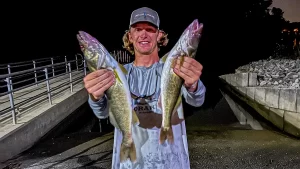Southern walleye fishing is gaining popularity, especially in areas like East Tennessee, where anglers have discovered thriving populations in local waterways. Current plays a crucial role in catching walleye, as these fish tend to position themselves along deep ledges, humps, and current seams when water is moving. Successful trolling often involves targeting these locations, using down and side imaging to locate fish near the bottom.
Hard, rocky bottoms are prime spots for walleye, especially along channel swings and lake points. Fish tend to stay close to the bottom, where lures like the Strike King KVD 100 jerkbait work well in shallow waters of 8-12 feet. In deeper areas, anglers often opt for the Bandit Walleye Deep Diver, adjusting line size to control depth. Bright colors like fire tiger or clown have proven successful in attracting strikes.

Trolling is best done at night, as walleye are nocturnal feeders. Anglers recommend trolling against the current with plenty of line between the boat and the lure. Trolling speeds should be monitored closely, generally ranging from 2 to 3 miles per hour, but adjusting based on the water’s current. Nighttime fishing, particularly between 10 p.m. and 2 a.m., tends to be the most productive, with many anglers reporting success in catching multiple walleye in one session.
For those located in the southeastern United States, night trolling for walleye offers not only exciting fishing action but also the opportunity for a great catch, perfect for a fish fry the following day. This method has become a tradition for many anglers in the region, making it a must-try for walleye enthusiasts.
Image/Source: Wired2Fish





